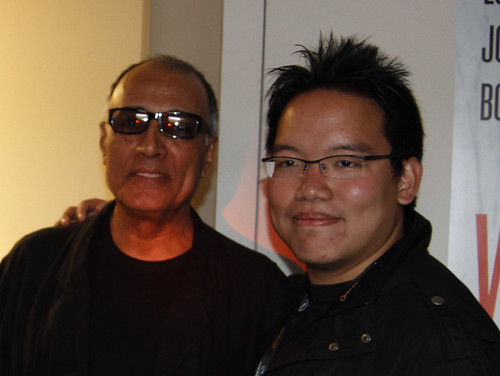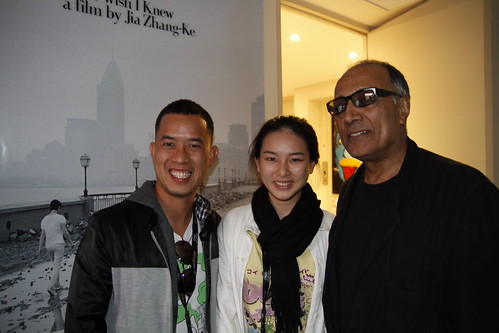Tuesday, March 28, 2017
Hello again, journal, let me tell you about my new film "Aqérat"
When was the last time I have actually posted here? Probably nearly 6 months ago, during the Tokyo International Film Festival. The truth is, ever since I figured that I can automatically post my Instagram posts here, I have gotten lazy.
But somehow, my Instagram pictures stopped appearing it, it's quite a bummer, but it means that I have to return and actually WRITE here. To my imaginary audience of one.
In that amount of time since I was gone, I have shot my new feature film, "Aqérat". That was late December. Been working on it since then.
"Aqérat", which means "life after death" in the Rohingyan language, tells the story of a desperate young woman named Hui Ling (played by regular collaborator Daphne Low) who gets involved in human trafficking. It's about the recent Rohingyan migrant crisis that had been happening the past few years, it's also a love story.
Film is shot in the Northern state of Kelantan, which is really close to the Thai-Malaysia border. Before the shoot, I've never been there before, but filmmaking is an act of constant exploration, thus it would have been a waste to not find a way to capture this beautiful, unique place onscreen.
Trusty TK the production designer and art director had once again uploaded production photos of the shoot. Great stuff, he deserved the Dongseo scholarship at last year's Asian Film Academy at the Busan International Film Festival :D
Wednesday, November 30, 2016
Ryusuke Hamaguchi's 5-hour opus HAPPY HOUR
Ryusuke Hamaguchi's wonderful HAPPY HOUR, like the Iwai Shunji retrospective, was also part of the Japan Now section in the Tokyo International Film Festival.
I need to give props to Japan Now. Ever since the festival started this section last year, with Ando-sensei (yup, my former university professor Kohei Ando-sensei1!!) serving as programming advisor, the section has become one of the main attractions of the festival. The screening of noteworthy (of commercial or critical merit) Japanese films of the past year, complete with Q and A sessions moderated by Ando-sensei, had been great!
I remember having dinner with Ando-sensei in August right after he had served as jury member of the Guanajuato International Film Festival (where he saw Happy Hour for the very first time and awarded it the Best International Feature Narrative award) and we discussed about the trickiness of trying to program this film at the Tokyo International Film Festival due to its length (5 hours!!!) I said to Ando-sensei that if the film would ever show in the festival, I will definitely go and see it.
I'm very glad Ando-sensei managed to program the film, and made the experience even richer by making it an all-nighter screening!
I wrote this a few hours after the screening:
Monday, November 28, 2016
My love letter to Iwai Shunji's Love Letter
I wrote this on Facebook last month, after watching Iwai Shunji's Love Letter at the Tokyo International Film Festival. I have seen this film countless times in various forms, on VCD, on DVD, on digital file, either on TV or on computer, but never on the big screen, so that particular screening in Tokyo left me overwhelmed, and of course, nostalgic.
Here's my love letter to the film Love Letter:
I saw Iwai Shunji's Love Letter (2005) on the big screen today. Sometimes you see a film at the right time, at the right age, so you fall in love with it in ways you cannot imagine.
It was 1998. I was 14 when I first saw Love Letter, I think this might be the film that made me fell in love with Japanese cinema, the emotional impact it left me was immense. The lyricism, the romanticism, the pain of unspoken love and the melancholy of memories, I was intoxicated by these vivid feelings through this film. I loved a little more, contemplated a little more, daydreamed a little more, became more obsessed with the snow. Films can do these things to you, when you see it at the right time, at the right age.
Monday, November 21, 2016
ASIAN THREE-FOLD MIRRORS: REFLECTIONS @ TOKYO INTERNATIONAL FILM FESTIVAL 2016
It's already been a month and I never had the chance to write about the Tokyo International Film Festival.
This always happens when I'm preparing for a film shoot. I lose track of time. Today becomes yesterday, tomorrow becomes today, and I don't even notice it.
Last month I went to the Tokyo International Film Festival for the world premiere of the omnibus project, Asian Three-Fold Mirror: Reflections. I was one of the producers of the segment, Pigeon by Isao Yukisada (along with Ming Jin and Shunsuke Koga-san)
So, here are some photos of me at the red carpet. I managed to meet popular actor Saitoh Takumi, whom I met two years ago in Bali when he was doing the film Taksu. I also met Rin Takanashi, the star of Abbas Kiarostami's final film Like Someone in Love.
Wednesday, September 14, 2016
Trailer of Asian Three-fold Mirror 2016 : Reflections (Brillante Mendoza, Isao Yukisada and Sotho Kulikar)
Earlier this year, I was involved as one of the producers for director Isao Yukisada's "Pigeon", his segment for the omnibus project Asian Three-fold Mirror 2016: Reflections 『アジア三面鏡2016:リフレクションズ』 (check out the photos posted by cast and crew), produced by The Japan Foundation Asian Center and Tokyo International Film Festival.
Its trailer is finally out!
English version.
And Japanese version.
The Japan Foundation Asia Center and Tokyo International Film Festival have co-produced the first of the Asian Omnibus Film series, Asian Three-Fold Mirror 2016: Reflections.
The Asian Three-Fold Mirror project brings together three globally-acclaimed, talented directors from Asia to co-create a series of omnibus films with a common theme. The first of the omnibus film series, Asian Three-Fold Mirror 2016, reflects on history and culture in their chosen countries to create new light. Under the theme of “Living in Asia”, crew and cast joined forces across national borders to depict the lives of characters who journey between Japan and Cambodia, the Philippines and Malaysia. New films have been created to help bring together the people in Asia.
“Asian Three-Fold Mirror 2016: Reflections”
■SHINIUMA Dead Horse
Director :BRILLANTE MA MENDOZA / Cast: LOU VELOSO
■”Pigeon”
Director :ISAO YUKISADA / Cast: MASAHIKO TSUGAWA、SHARIFAH AMANI、MASATOSHI NAGASE
■”Beyond The Bridge”
Director :SOTHO KULIKAR / Cast: MASAYA KATO、CHUMVAN SODHACHIVY、OSAMU SHIGEMATSU
Co-production by The Japan Foundation Asia Center & Tokyo International Film Festival / Supported by Imagica / General Producer: TAKEO HISAMATSU
(C)2016 The Japan Foundation, All Rights Reserved.
2016/Japan/Color/Vista
http://asian3mirror.jfac.jp/
Monday, July 18, 2016
Shohei Imamura's Karayuki-san, the Making of a Prostitute (1975)
For reasons I cannot comprehend or explain, it became something that had haunted my mind for the past half decade. Maybe because this was a part of Japanese/ Malaysian history (countries obviously close to my heart) that was gradually being forgotten, so I became increasingly curious, and determined to commit their stories into film.
There are publications about them, but films? The only ones I am aware of are still Kumai Kei's Oscar-nominated SANDAKAN NO. 8 (1974) and Shohei Imamura's KARAYUKI-SAN, THE MAKING OF A PROSTITUTE (1975). The former is a fictionalized retelling of their plight, the latter is a documentary.
I finally found time to watch the documentary last night. In the documentary, the director Shohei Imamura was interviewing an old lady named Kikuyo Zendo, a former Karayuki-san. As they walked through familiar places like Klang and revisit locations of her memories, before finally revealing that at that time she was staying at Petaling Jaya, I was sort of shocked. Was she staying within my neighbourhood? Where I live now is an area that had existed long before my birth. In 30 years of my life I have been staying mostly in this house. A decade or two before my birth, she was probably roaming the same area.
People come and go, history happens, time is constantly moving. I don't know why this felt like such a big deal. Perhaps I am not used to seeing familiar places from a different time through the prisms of another.
In this effortless documentary I relearned many things that I have learnt during my years of researching the Karayuki-san, while also getting nuggets of information that I never knew before. When everything is recounted in first person, and committed to celluloid, the feeling is a little different from reading it from books.
This documentary is hard to find, I think it's still included in Shohei Imamura's A Man Vanishes DVD.
But you can find the entire film on Youtube, unfortunately, it only has French subtitles. Yet if you are curious, I still recommend that you scan through the film. Many of it transcend language anyway.
One thing I need to note is that many publications and articles about this documentary, including the seminal AH KU AND THE KARAYUKI-SAN book have mentioned that the locales visited by Imamura and Kikuyo were in Singapore.
But watching the documentary myself. I'm rather sure that all of Kikuyo's interviews were conducted in Malaysia, in areas around Kuala Lumpur. Like Cheras (the nursing home), Klang (the port at the opening, the ship, the previous brothels), Petaling Jaya (Kikuyo's home) etc. Even the cemetery they went to seemed very much like the Japanese cemetery in Kuala Lumpur, and not Singapore.
Friday, July 15, 2016
Remembering Abbas Kiarostami and rediscovering his films


Cannes Film Festival 2010
Merely that Ming Jin and I, along with Fooi Mun, our The Tiger Factory lead actress saw him at the MK2 party and had to hurriedly (and politely) stop him to take these photos before he was about to leave.
-
If you had of asked me on a given day whether I'd one day end up passionately defending fanfiction, I would have given you a strange l...
-
**Mild spoiler warning for both versions of Cinema Paradiso** Was watching the director's cut version of Cinema Paradiso (called th...
-
Mishima is a writer associated with scale and grand gestures. Apart from his colorful life and the obviously theatrical nature of his publi...

